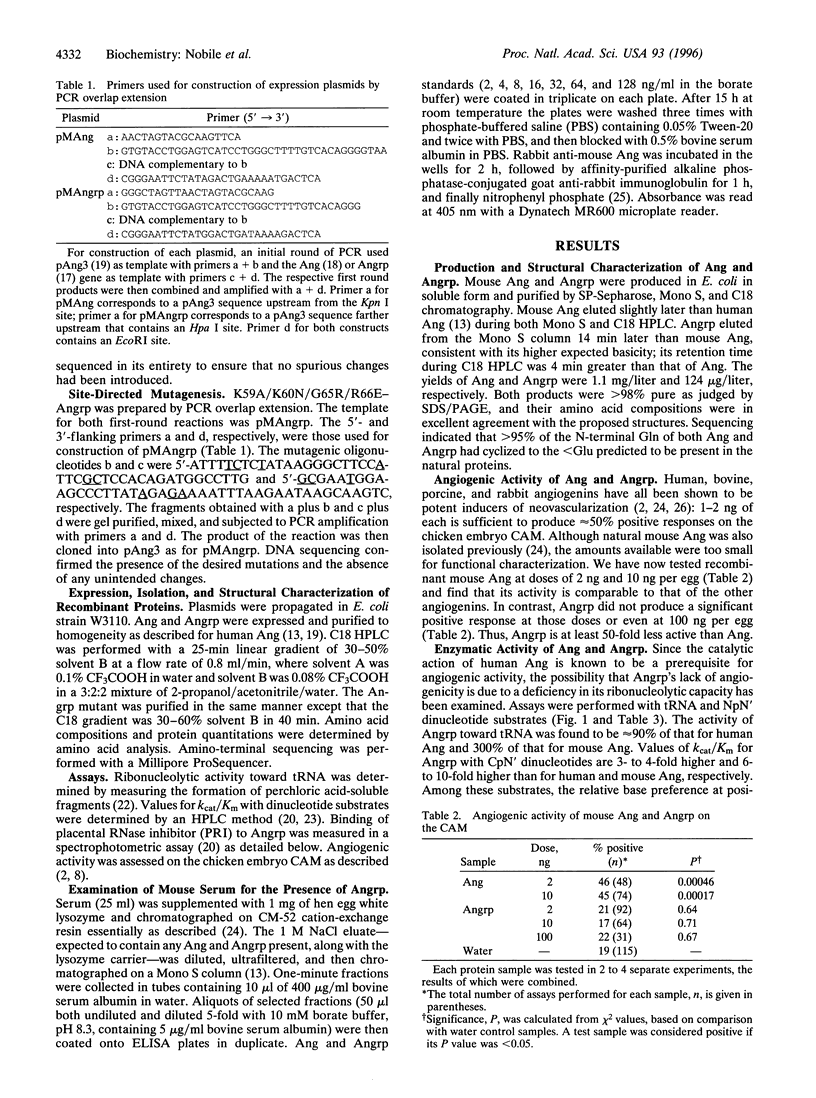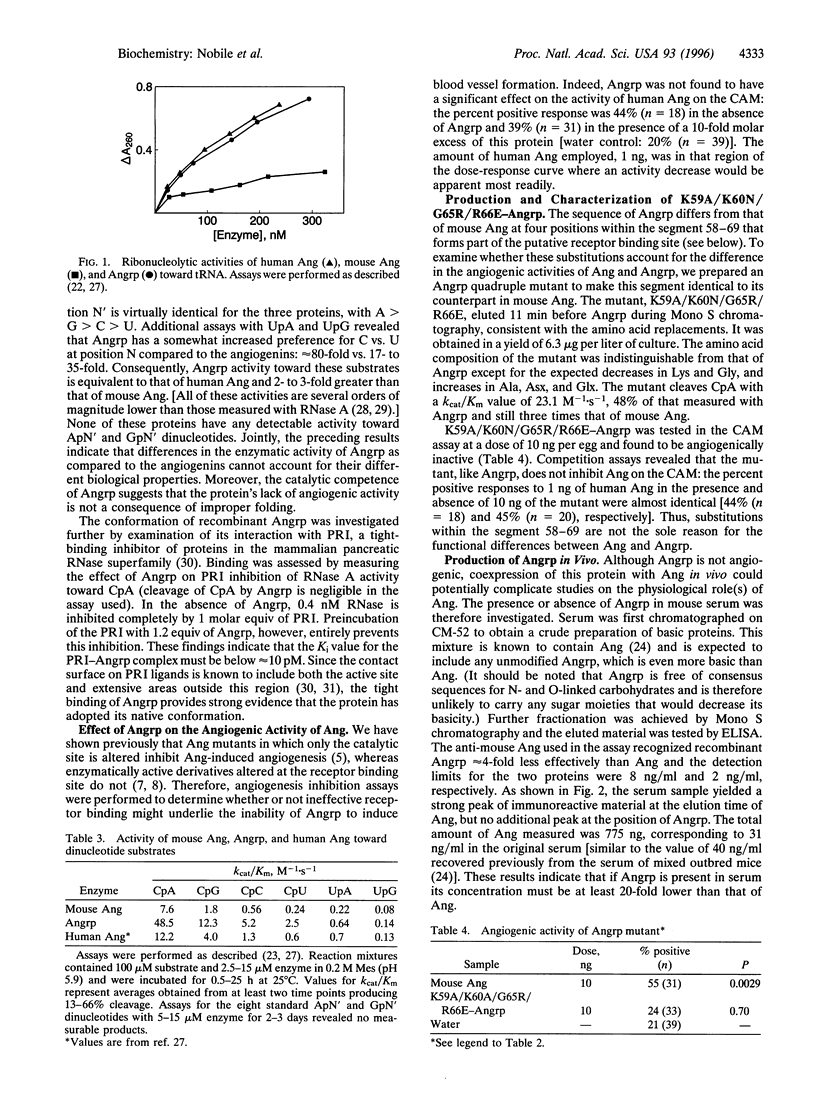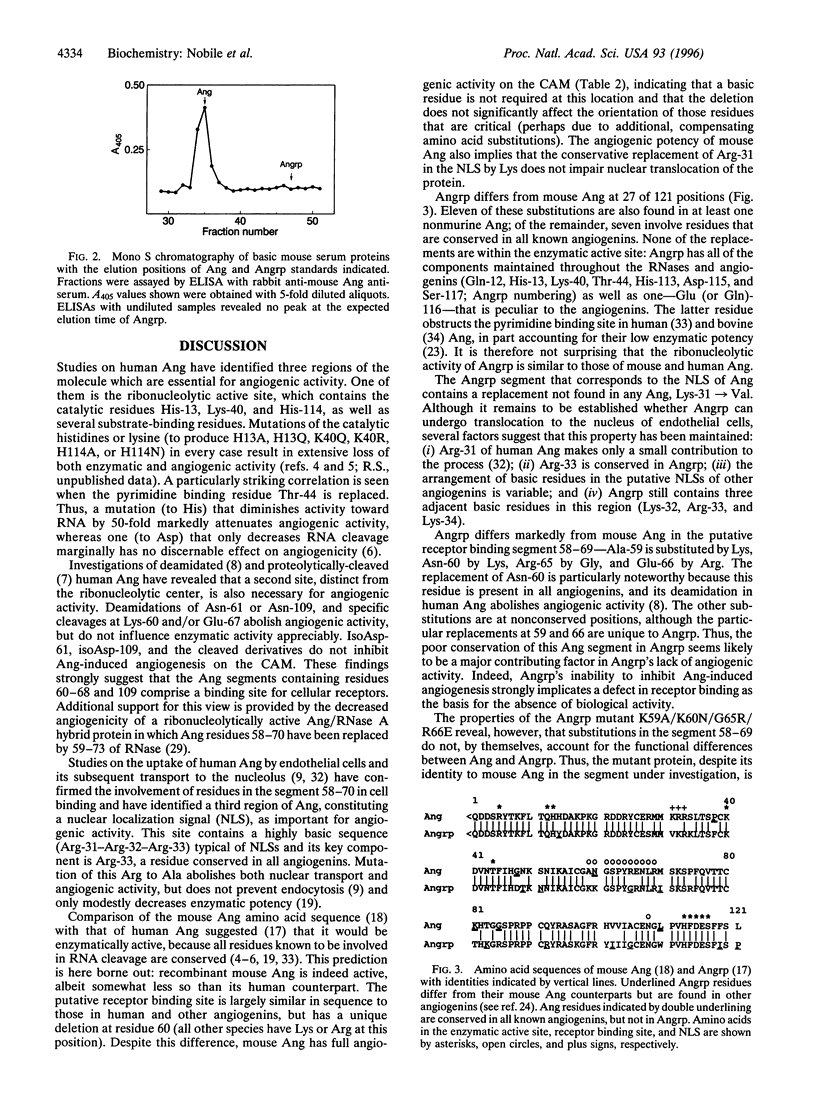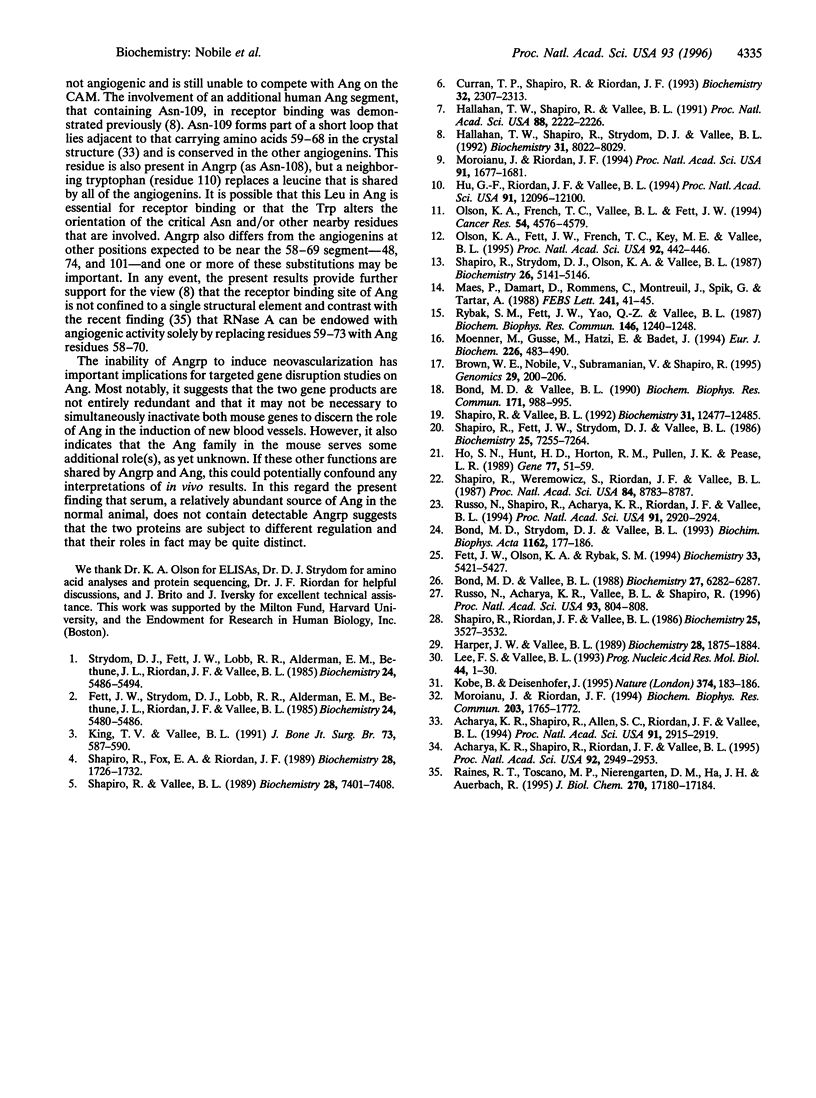Abstract
Angiogenin-related protein (Angrp), the putative product of a recently discovered mouse gene, shares 78% sequence identity with mouse angiogenin (Ang). In the present study, the relationship of Angrp to Ang has been investigated by producing both proteins in bacteria and comparing their functional properties. We find that mouse Ang is potently angiogenic, but Angrp is not, even when assayed at relatively high doses. A deficiency in catalytic capacity, which is essential for the biological activity of Ang, does not appear to underlie Angrp's lack of angiogenicity. In fact, Angrp has somewhat greater ribonucleolytic activity toward tRNA and dinucleotide substrates than does Ang. Instead, an inability to bind cellular receptors is implicated since Angrp does not inhibit Ang-induced angiogenesis. Poor conservation of the Ang receptor recognition sequence 58-69 in Angrp most likely contributes to this defect. However, other substitutions must also influence receptor binding since an Angrp quadruple mutant that is identical to Ang in this segment still lacks both angiogenic activity and the capacity to inhibit Ang. The functional differences between Ang and Angrp, together with evidence presented herein that Angrp is regulated differently than Ang, suggest that the roles of the two proteins in vivo may be quite distinct.
Full text
PDF




Selected References
These references are in PubMed. This may not be the complete list of references from this article.
- Acharya K. R., Shapiro R., Allen S. C., Riordan J. F., Vallee B. L. Crystal structure of human angiogenin reveals the structural basis for its functional divergence from ribonuclease. Proc Natl Acad Sci U S A. 1994 Apr 12;91(8):2915–2919. doi: 10.1073/pnas.91.8.2915. [DOI] [PMC free article] [PubMed] [Google Scholar]
- Acharya K. R., Shapiro R., Riordan J. F., Vallee B. L. Crystal structure of bovine angiogenin at 1.5-A resolution. Proc Natl Acad Sci U S A. 1995 Mar 28;92(7):2949–2953. doi: 10.1073/pnas.92.7.2949. [DOI] [PMC free article] [PubMed] [Google Scholar]
- Bond M. D., Strydom D. J., Vallee B. L. Characterization and sequencing of rabbit, pig and mouse angiogenins: discernment of functionally important residues and regions. Biochim Biophys Acta. 1993 Mar 5;1162(1-2):177–186. doi: 10.1016/0167-4838(93)90145-h. [DOI] [PubMed] [Google Scholar]
- Bond M. D., Vallee B. L. Isolation and sequencing of mouse angiogenin DNA. Biochem Biophys Res Commun. 1990 Sep 28;171(3):988–995. doi: 10.1016/0006-291x(90)90781-h. [DOI] [PubMed] [Google Scholar]
- Bond M. D., Vallee B. L. Isolation of bovine angiogenin using a placental ribonuclease inhibitor binding assay. Biochemistry. 1988 Aug 23;27(17):6282–6287. doi: 10.1021/bi00417a013. [DOI] [PubMed] [Google Scholar]
- Brown W. E., Nobile V., Subramanian V., Shapiro R. The mouse angiogenin gene family: structures of an angiogenin-related protein gene and two pseudogenes. Genomics. 1995 Sep 1;29(1):200–206. doi: 10.1006/geno.1995.1232. [DOI] [PubMed] [Google Scholar]
- Curran T. P., Shapiro R., Riordan J. F. Alteration of the enzymatic specificity of human angiogenin by site-directed mutagenesis. Biochemistry. 1993 Mar 9;32(9):2307–2313. doi: 10.1021/bi00060a023. [DOI] [PubMed] [Google Scholar]
- Fett J. W., Olson K. A., Rybak S. M. A monoclonal antibody to human angiogenin. Inhibition of ribonucleolytic and angiogenic activities and localization of the antigenic epitope. Biochemistry. 1994 May 10;33(18):5421–5427. doi: 10.1021/bi00184a010. [DOI] [PubMed] [Google Scholar]
- Fett J. W., Strydom D. J., Lobb R. R., Alderman E. M., Bethune J. L., Riordan J. F., Vallee B. L. Isolation and characterization of angiogenin, an angiogenic protein from human carcinoma cells. Biochemistry. 1985 Sep 24;24(20):5480–5486. doi: 10.1021/bi00341a030. [DOI] [PubMed] [Google Scholar]
- Hallahan T. W., Shapiro R., Strydom D. J., Vallee B. L. Importance of asparagine-61 and asparagine-109 to the angiogenic activity of human angiogenin. Biochemistry. 1992 Sep 1;31(34):8022–8029. doi: 10.1021/bi00149a036. [DOI] [PubMed] [Google Scholar]
- Hallahan T. W., Shapiro R., Vallee B. L. Dual site model for the organogenic activity of angiogenin. Proc Natl Acad Sci U S A. 1991 Mar 15;88(6):2222–2226. doi: 10.1073/pnas.88.6.2222. [DOI] [PMC free article] [PubMed] [Google Scholar]
- Harper J. W., Vallee B. L. A covalent angiogenin/ribonuclease hybrid with a fourth disulfide bond generated by regional mutagenesis. Biochemistry. 1989 Feb 21;28(4):1875–1884. doi: 10.1021/bi00430a067. [DOI] [PubMed] [Google Scholar]
- Ho S. N., Hunt H. D., Horton R. M., Pullen J. K., Pease L. R. Site-directed mutagenesis by overlap extension using the polymerase chain reaction. Gene. 1989 Apr 15;77(1):51–59. doi: 10.1016/0378-1119(89)90358-2. [DOI] [PubMed] [Google Scholar]
- Hu G., Riordan J. F., Vallee B. L. Angiogenin promotes invasiveness of cultured endothelial cells by stimulation of cell-associated proteolytic activities. Proc Natl Acad Sci U S A. 1994 Dec 6;91(25):12096–12100. doi: 10.1073/pnas.91.25.12096. [DOI] [PMC free article] [PubMed] [Google Scholar]
- King T. V., Vallee B. L. Neovascularisation of the meniscus with angiogenin. An experimental study in rabbits. J Bone Joint Surg Br. 1991 Jul;73(4):587–590. doi: 10.1302/0301-620X.73B4.1712788. [DOI] [PubMed] [Google Scholar]
- Kobe B., Deisenhofer J. A structural basis of the interactions between leucine-rich repeats and protein ligands. Nature. 1995 Mar 9;374(6518):183–186. doi: 10.1038/374183a0. [DOI] [PubMed] [Google Scholar]
- Lee F. S., Vallee B. L. Structure and action of mammalian ribonuclease (angiogenin) inhibitor. Prog Nucleic Acid Res Mol Biol. 1993;44:1–30. doi: 10.1016/s0079-6603(08)60215-9. [DOI] [PubMed] [Google Scholar]
- Maes P., Damart D., Rommens C., Montreuil J., Spik G., Tartar A. The complete amino acid sequence of bovine milk angiogenin. FEBS Lett. 1988 Dec 5;241(1-2):41–45. doi: 10.1016/0014-5793(88)81027-5. [DOI] [PubMed] [Google Scholar]
- Moenner M., Gusse M., Hatzi E., Badet J. The widespread expression of angiogenin in different human cells suggests a biological function not only related to angiogenesis. Eur J Biochem. 1994 Dec 1;226(2):483–490. doi: 10.1111/j.1432-1033.1994.tb20073.x. [DOI] [PubMed] [Google Scholar]
- Moroianu J., Riordan J. F. Identification of the nucleolar targeting signal of human angiogenin. Biochem Biophys Res Commun. 1994 Sep 30;203(3):1765–1772. doi: 10.1006/bbrc.1994.2391. [DOI] [PubMed] [Google Scholar]
- Moroianu J., Riordan J. F. Nuclear translocation of angiogenin in proliferating endothelial cells is essential to its angiogenic activity. Proc Natl Acad Sci U S A. 1994 Mar 1;91(5):1677–1681. doi: 10.1073/pnas.91.5.1677. [DOI] [PMC free article] [PubMed] [Google Scholar]
- Olson K. A., Fett J. W., French T. C., Key M. E., Vallee B. L. Angiogenin antagonists prevent tumor growth in vivo. Proc Natl Acad Sci U S A. 1995 Jan 17;92(2):442–446. doi: 10.1073/pnas.92.2.442. [DOI] [PMC free article] [PubMed] [Google Scholar]
- Olson K. A., French T. C., Vallee B. L., Fett J. W. A monoclonal antibody to human angiogenin suppresses tumor growth in athymic mice. Cancer Res. 1994 Sep 1;54(17):4576–4579. [PubMed] [Google Scholar]
- Raines R. T., Toscano M. P., Nierengarten D. M., Ha J. H., Auerbach R. Replacing a surface loop endows ribonuclease A with angiogenic activity. J Biol Chem. 1995 Jul 21;270(29):17180–17184. doi: 10.1074/jbc.270.29.17180. [DOI] [PubMed] [Google Scholar]
- Russo N., Acharya K. R., Vallee B. L., Shapiro R. A combined kinetic and modeling study of the catalytic center subsites of human angiogenin. Proc Natl Acad Sci U S A. 1996 Jan 23;93(2):804–808. doi: 10.1073/pnas.93.2.804. [DOI] [PMC free article] [PubMed] [Google Scholar]
- Russo N., Shapiro R., Acharya K. R., Riordan J. F., Vallee B. L. Role of glutamine-117 in the ribonucleolytic activity of human angiogenin. Proc Natl Acad Sci U S A. 1994 Apr 12;91(8):2920–2924. doi: 10.1073/pnas.91.8.2920. [DOI] [PMC free article] [PubMed] [Google Scholar]
- Rybak S. M., Fett J. W., Yao Q. Z., Vallee B. L. Angiogenin mRNA in human tumor and normal cells. Biochem Biophys Res Commun. 1987 Aug 14;146(3):1240–1248. doi: 10.1016/0006-291x(87)90781-9. [DOI] [PubMed] [Google Scholar]
- Shapiro R., Fett J. W., Strydom D. J., Vallee B. L. Isolation and characterization of a human colon carcinoma-secreted enzyme with pancreatic ribonuclease-like activity. Biochemistry. 1986 Nov 18;25(23):7255–7264. doi: 10.1021/bi00371a002. [DOI] [PubMed] [Google Scholar]
- Shapiro R., Fox E. A., Riordan J. F. Role of lysines in human angiogenin: chemical modification and site-directed mutagenesis. Biochemistry. 1989 Feb 21;28(4):1726–1732. doi: 10.1021/bi00430a045. [DOI] [PubMed] [Google Scholar]
- Shapiro R., Riordan J. F., Vallee B. L. Characteristic ribonucleolytic activity of human angiogenin. Biochemistry. 1986 Jun 17;25(12):3527–3532. doi: 10.1021/bi00360a008. [DOI] [PubMed] [Google Scholar]
- Shapiro R., Strydom D. J., Olson K. A., Vallee B. L. Isolation of angiogenin from normal human plasma. Biochemistry. 1987 Aug 11;26(16):5141–5146. doi: 10.1021/bi00390a037. [DOI] [PubMed] [Google Scholar]
- Shapiro R., Vallee B. L. Identification of functional arginines in human angiogenin by site-directed mutagenesis. Biochemistry. 1992 Dec 15;31(49):12477–12485. doi: 10.1021/bi00164a026. [DOI] [PubMed] [Google Scholar]
- Shapiro R., Vallee B. L. Site-directed mutagenesis of histidine-13 and histidine-114 of human angiogenin. Alanine derivatives inhibit angiogenin-induced angiogenesis. Biochemistry. 1989 Sep 5;28(18):7401–7408. doi: 10.1021/bi00444a038. [DOI] [PubMed] [Google Scholar]
- Shapiro R., Weremowicz S., Riordan J. F., Vallee B. L. Ribonucleolytic activity of angiogenin: essential histidine, lysine, and arginine residues. Proc Natl Acad Sci U S A. 1987 Dec;84(24):8783–8787. doi: 10.1073/pnas.84.24.8783. [DOI] [PMC free article] [PubMed] [Google Scholar]
- Strydom D. J., Fett J. W., Lobb R. R., Alderman E. M., Bethune J. L., Riordan J. F., Vallee B. L. Amino acid sequence of human tumor derived angiogenin. Biochemistry. 1985 Sep 24;24(20):5486–5494. doi: 10.1021/bi00341a031. [DOI] [PubMed] [Google Scholar]


